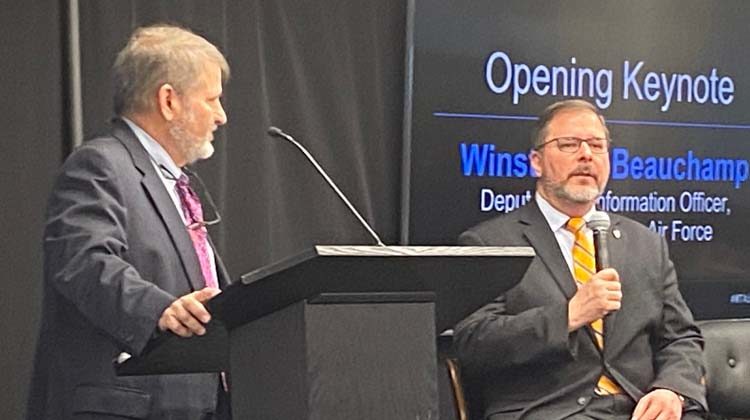The Air Force’s Deputy Chief Information Officer called on commercial industry for help as the service looks to modernize its information technology programs and consolidate networks. Speaking at a Washington Technology breakfast with industry March 10, Winston Beauchamp outlined a number of opportunities for industry and emphasized the Air Force’s ongoing efforts to modernize in areas that have seen neglect in recent years.
The pathway to these modernization efforts, he noted, is the DOD’s Zero Trust Strategy and Roadmap, a “department-wide Zero Trust cybersecurity framework that will reduce the attack surface, enable risk management and effective data sharing in partnership environments, and quickly contain and remediate adversary activities,” according to the Air Force.
“We use integrated systems where necessary; we use federated capabilities where possible, to retain some flexibility across the services so we don’t have to force us into lockstep,” Beauchamp said. “That is going to be the key enabler to making sure we can exchange both identity information and role-based information across these applications to protect the data where it lives instead of the network it lives on.”
Beauchamp told attendees he wants industry to help the Air Force understand how it’s done. But such an effort presents many challenges, particularly the long-term impact of things like sequestration and the tough choices the force had to make in the early-to-mid 2010s.
“The problem is when you take a modernization holiday of about a decade, eventually it’s going to catch up to you, and that’s exactly what’s happening right now,” he said. “We’re seeing that in device failures, we’re seeing it in network latency problems. … It’s actually harder to modernize the older your equipment is, and it takes a larger amount of money and time to overcome that much tech debt.”
Beauchamp said the Air Force is about to start Enterprise Information Technology as-a-Service (EITaaS) Wave 1, which is the implementation of “consolidated network management and security help desk services,” which will be quickly followed by Wave 2, which includes base area network updates at 185 bases—with priority given to crucial outposts near conflict areas.
These modernization areas are where he wants help from industry, to help the Air Force identify “commercial best practices” and help the force understand how these things are executed in the commercial sector.
“In many cases, that means working that business case a little bit harder with our folks to make them understand where the things that you do on a regular basis—when you do these types of modernizations in the real world—how it can be applied to military bases, while still complying with all of the rules and regulations you have to do for a DOD acquisition,” Beauchamp said.
He also spoke to the Air Force’s major effort to transition to the cloud and highlighted Cloud One, the DOD’s first hybrid multi-cloud program. It contains development and security service layers that users can employ for application migration to the cloud or developing applications in the cloud.
Regarding Air Force culture, Beauchamp noted that EITaaS is quite a departure from earlier acquisition efforts, where a vendor would, for example, install equipment at a base or locality and then operations and support would be conducted by Air Force personnel and support. EITaaS is structured differently, in that the vendor would participate in the operation of the product—basically provide the service to the Air Force.
“We’re entering into a service-level agreement,” he said. “We’re enabling that vendor then to upgrade or replace the equipment as needed, within the cost of the contract to make sure they can meet that support agreement.”
Ultimately, Beauchamp said, this will free up service members to devote their expertise on other responsibilities and allow the Air Force to make better use of its talent.
Joseph “Mike” McWilliams, director of staff for the Air Force Small Business and Acquisition Program Manager, then provided a crash course on best practices for vendors to better connect their capabilities with the Air Force. Above all, McWilliams insisted vendors be clear and concise in their capability statements, what services they provide, and how their expertise can meet the Air Force’s needs.
McWilliams lamented the many proposals he’s reviewed over the years that are short on substance and long on “fluff.” He urged prospective vendors to understand those reviewing proposals typically need to make quick decisions and want specifics about vendor capability. He also strongly encouraged vendors to attend industry days.
“If you’re there in the audience and you have a better idea or you know what you can do, help the program manager and the contracting officer up there … develop that acquisition strategy to where there will be set asides to use small businesses,” he said. “Because they may not even be thinking about that until they find out there’s two or more of you out there in the audience who can do this.”
